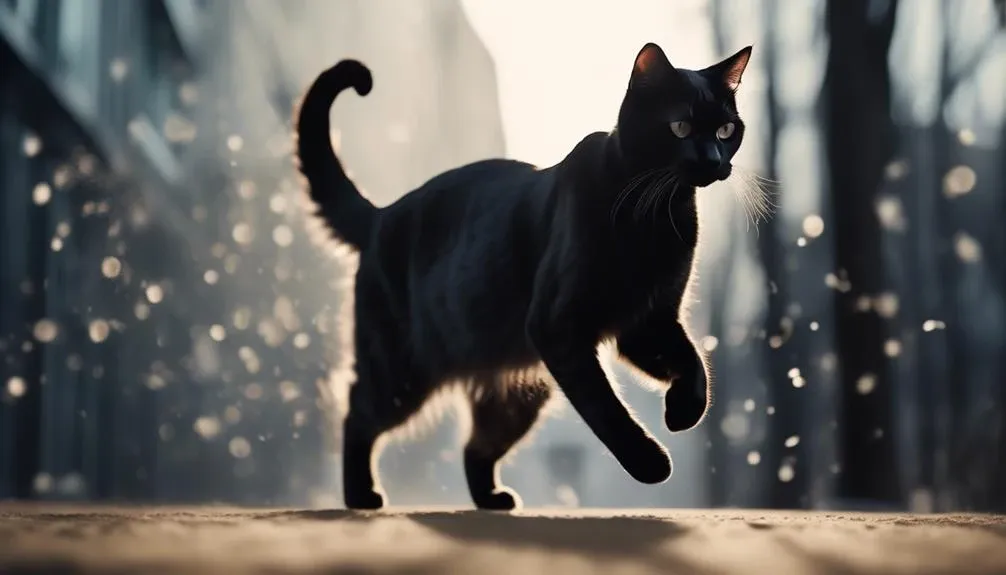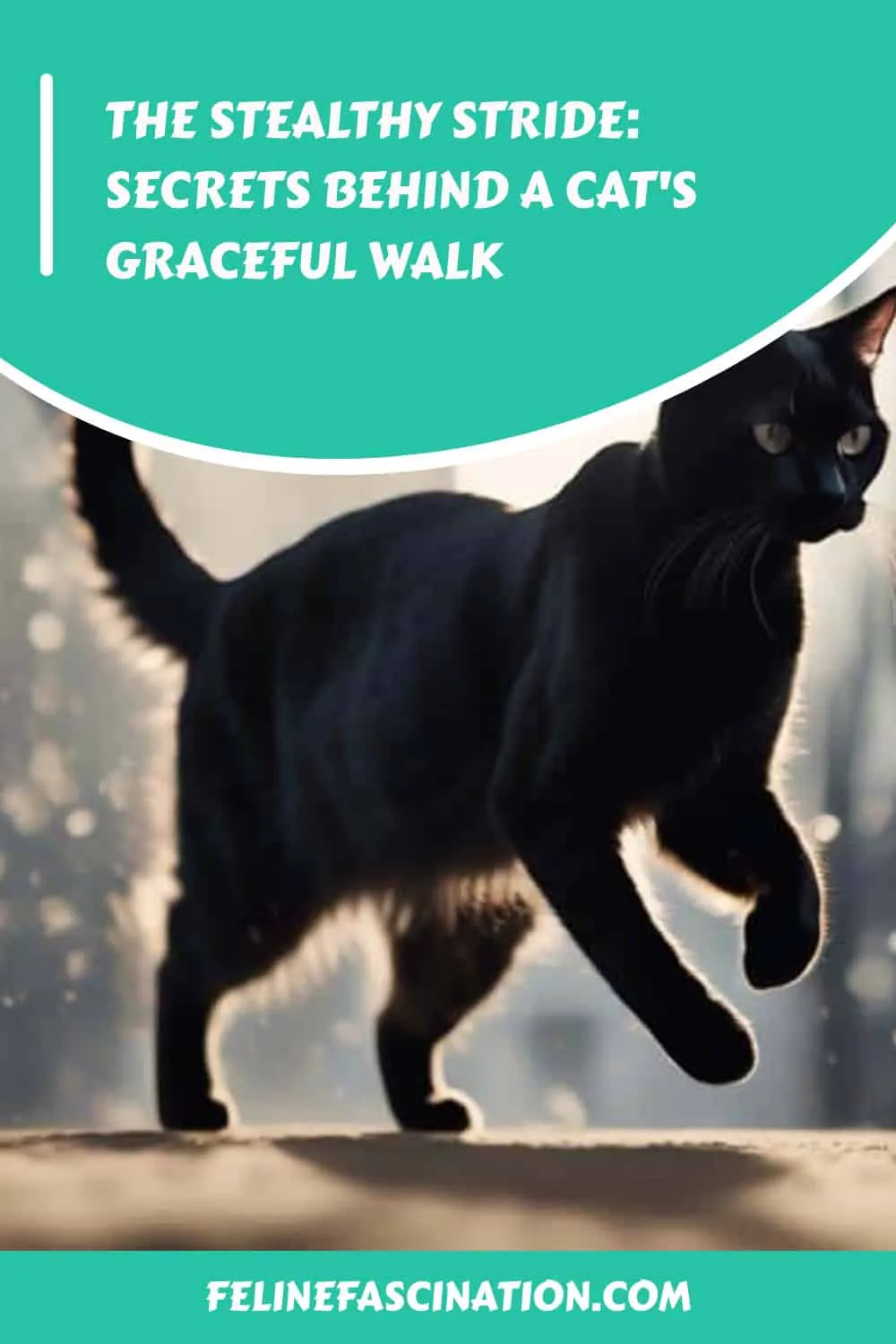The Best Fluffy Pancakes recipe you will fall in love with. Full of tips and tricks to help you make the best pancakes.

The art of a cat's graceful walk has long captured the imagination of observers. They move with a fluidity and poise that seems almost otherworldly. But what is it that makes their stride so stealthy and elegant? How do they manage to glide across the room without making a sound?
In this discussion, we will explore the secrets behind the cat's mysterious walk. We will unravel the intricate mechanics that contribute to their unmatched agility and grace. From the unique four-beat gait to the delicate balance achieved through weight distribution, we will uncover the hidden techniques that make a cat's stride truly remarkable.
So, join us as we embark on a journey into the captivating world of feline locomotion. Every step holds a secret waiting to be unraveled.
Key Takeaways
- Cats walk on their toes, which contributes to their quiet movement and allows them to move silently and efficiently.
- Cats use a four-beat gait, where the front and back legs on each side move together, giving them balance and stability while walking.
- Cats maintain stealth by keeping their bodies low to the ground and using a method called direct register, where the hind paws land in the same spot as the front paws, reducing the noise they make.
- Limping or lameness in cats can be caused by various factors such as paw injuries, torn ligaments, bone tumors, arthritis, and more, and should be addressed by a veterinarian if observed. Ataxia, characterized by unsteady walking and abnormal paw movements, can also indicate underlying issues that require veterinary attention.
Anatomy of a Cat's Walk
The anatomy of a cat's walk is a fascinating combination of biomechanics and specialized adaptations that enable these graceful creatures to move silently and efficiently.
One key aspect of a cat's walk is the use of their toe pads. These soft pads, located at the base of each toe, provide traction and cushioning while walking. They also allow cats to navigate various surfaces with ease, including slippery or uneven terrain.
Additionally, the role of muscles in cat walking is crucial. The muscles in a cat's legs work together to produce the coordinated movements required for walking. The powerful thigh muscles propel the cat forward, while the muscles in the lower leg, such as the gastrocnemius and flexor digitorum muscles, control the extension and flexion of the toes, ensuring a smooth and efficient walking motion.
Understanding the anatomy and mechanics of a cat's walk helps us appreciate the elegance and efficiency of their movements.
The Four-Beat Gait
Cats utilize a distinct four-beat gait, where the synchronized movement of their front and back legs on each side enables them to walk with grace and precision. Understanding feline biomechanics allows us to appreciate the intricate coordination required for this elegant gait.
The role of muscles in cat walking is crucial in achieving this synchronized movement. The muscles in a cat's front and back legs work together to propel the body forward in a fluid motion. The front legs extend forward while the back legs push off, creating a seamless transition. This coordinated movement allows cats to maintain balance and control while walking.
The precise timing and activation of these muscles ensure that each footfall is deliberate and efficient, allowing cats to move stealthily and with remarkable agility.
Weight Distribution in Cat Walking
In the mechanics of a cat's walk, an essential aspect to consider is the distribution of weight throughout their body. The impact of weight distribution on a cat's walking efficiency is significant.
Cats have a unique body structure that allows them to distribute their weight efficiently, contributing to their graceful and agile movements. The majority of a cat's weight is concentrated on their front paws while walking. This weight distribution helps provide stability and balance, allowing them to move with precision and control.
Additionally, the role of muscle strength in a cat's walking stride is crucial. Strong muscles in their legs and shoulders enable them to propel themselves forward and maintain a steady gait.
The Art of Silent Walking
After understanding the mechanics of a cat's weight distribution and muscle strength in their walking stride, we can now explore the fascinating aspect of their ability to move silently – the art of silent walking. Cats are renowned for their stealthy movement and feline agility, which allows them to sneak up on prey without making a sound.
Here are three key factors that contribute to their silent walking:
- Soft Pads: Cats have soft, padded paws that act as natural shock absorbers, reducing the impact and noise when they walk.
- Flexibility: Cats have a highly flexible spine, allowing them to move their bodies with fluidity and precision. This flexibility enables them to walk silently by adjusting their posture and distributing their weight effectively.
- Muscular Control: Cats have exceptional muscle control, especially in their hind legs. This allows them to make small, controlled movements, minimizing any noise caused by their footsteps.
Direct Register: A Stealthy Technique
Direct register is a highly effective and stealthy walking technique employed by cats. When using this technique, a cat's hind paws land in the same spot as the front paws, reducing the noise they make while walking. This is particularly useful when cats are stalking prey, allowing them to approach silently and undetected.
However, direct registering requires more energy and is therefore used selectively. It is important to note that paw injuries can play a role in limping, affecting a cat's ability to walk using this technique. Paw injuries, such as sprains, broken bones, or torn ligaments, can cause pain and lameness, making it difficult for cats to execute their stealthy hunting techniques.
Understanding and addressing paw injuries is crucial in ensuring a cat's graceful and effective walk.
Occasions for Direct Registering
When considering the occasions in which cats employ direct registering, it is important to understand the strategic nature of this stealthy walking technique. Direct registering, although primarily associated with cats, is not exclusive to them. Other animals, such as certain species of dogs and foxes, also utilize this method of walking.
There are several benefits to direct registering, which explain why cats employ it on specific occasions.
- Sneaking up on prey: Direct registering allows cats to move silently and reduce the noise they make when walking. This is crucial when stalking prey, as it increases their chances of a successful hunt.
- Maintaining stealth: By landing their hind paws in the same spot as their front paws, cats minimize the disturbance they create while walking. This helps them maintain a low profile and remain undetected.
- Enhancing agility and balance: Direct registering requires cats to carefully coordinate their movements, improving their agility and balance. This allows them to navigate challenging terrains or narrow spaces with ease.
Understanding the occasions and advantages of direct registering provides valuable insights into the stealthy nature of a cat's graceful walk.
Common Causes of Limping in Cats
One of the most common causes of limping in cats is injury or trauma to the paws or limbs. This can include wounds, fractures, sprains, or torn ligaments. Cats are known for their agility, but accidents can happen, especially when they jump from high places or engage in rough play.
Other causes of limping in cats can include bone tumors, arthritis, and blood clots. It is important for cat owners to pay attention to subtle signs of limb pain, such as reluctance to jump or run, and excessive licking of the painful leg. If you notice your cat limping, it is recommended to make an appointment with your veterinarian for a thorough examination and appropriate treatment.
Preventing limping in cats involves creating a safe environment, minimizing potential hazards, and providing regular exercise and proper nutrition to maintain healthy bones and muscles.
Treatment options for ataxia in cats, which may cause abnormal walking, depend on the underlying cause and may include medication, physical therapy, or surgery.
Signs of Limb Pain in Cats
In order to properly address the signs of limb pain in cats, it is essential to closely observe their behavior and physical cues, especially when considering the common causes of limping mentioned in the previous subtopic.
Some subtle signs of pain in cats include:
- Reluctance to engage in normal activities: Cats experiencing limb pain may be hesitant to jump, climb, or run. They may show a decrease in their usual level of activity.
- Excessive licking: Cats may lick the painful leg excessively as a way to alleviate discomfort. This excessive grooming behavior can be a sign of limb pain.
- Changes in gait: Cats in pain may exhibit an altered walking pattern, such as limping, favoring one leg, or dragging their toes. These changes in gait are a clear indication of discomfort.
Understanding Ataxia in Cats
Ataxia, a neurological condition affecting cats, is characterized by an unsteady gait, dragging toes, or abnormally high paw lifts. It can be caused by various factors, including brain or spinal cord issues, inner ear problems, or even certain toxins.
In some cases, ataxia may be a result of genetic abnormalities or degenerative diseases. To determine the underlying cause, a thorough examination and diagnostic tests such as blood work, imaging, or cerebrospinal fluid analysis may be necessary.
Treatment options for ataxia in cats depend on the underlying cause and may include medication to manage symptoms, physical therapy to improve coordination and balance, or surgical intervention in cases of spinal cord compression. Rehabilitation exercises and environmental modifications can also help cats with ataxia regain mobility and function.
It is crucial to consult with a veterinarian for an accurate diagnosis and appropriate treatment plan.
Seeking Veterinary Help for Walking Issues
To address walking issues in cats, seeking veterinary assistance is crucial for accurate diagnosis and appropriate treatment. Veterinary professionals have the knowledge and expertise to identify the underlying cause of walking problems and provide suitable interventions.
Here are some reasons why veterinary help should be sought for managing walking issues in cats:
- Accurate diagnosis: Veterinarians can perform a thorough physical examination and diagnostic tests to determine the exact cause of the walking problem. This may include X-rays, blood tests, or neurological evaluations.
- Veterinary treatment options: Once the cause is identified, veterinarians can recommend appropriate treatment options. This may include medications, physical therapy, surgery, or lifestyle modifications to manage pain, improve mobility, or address any underlying medical conditions.
- Managing walking issues: Veterinarians can guide pet owners on how to effectively manage walking issues in cats. They can provide advice on home care, assistive devices, and exercise programs that can help improve strength, balance, and coordination in cats with walking problems.
Conclusion
In conclusion, the cat's graceful walk is a testament to their remarkable agility and hunting abilities. Through their unique four-beat gait and the utilization of direct register, cats have mastered the art of silent and stealthy movement.
However, it is important to be vigilant for any signs of limping or ataxia, as these may indicate underlying health issues. Seeking prompt veterinary care is crucial in maintaining a cat's mobility and overall well-being, ensuring that they can continue to navigate the world with their characteristic grace.










